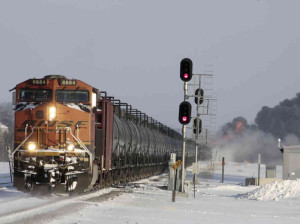Image Source: npr.org
Clyde Sharpe
President of International Sales at Elasto Proxy
First there was the deadly rail disaster in nearby Lac- Mégantic, Quebec. Then there was the oil spill that spoiled the beaches of Ao Prao, Thailand. A pair of pipeline explosions in Quindao, China devastated sections of that historic city. An oil-train derailment in Gainford, Alberta brought Canadians’ attention back home. Fall turned to winter, and we wondered how Casselton, North Dakota would face the fire.
The Casselton Oil Train Derailment
On a cold December afternoon, approximately 20 oil tankers in a mile-long train jumped the tracks near Casselton in southeast North Dakota. The fire that blazed was so intense that first responders couldn’t get close enough to count the damaged rail cars. Although no one was injured, residents felt the fire’s fury. Explosions on the outskirts of town lasted for hours, shaking homes and businesses.
When the wind changed direction, meteorologists worried that the plume of smoke from the gigantic fireball could engulf the community. The North Dakota Department of Health warned that exposure to burning crude oil could cause coughing, shortness of breath, and itching or watery eyes. Residents with asthma, bronchitis, and emphysema were advised to stay indoors.
North American Rail Safety
As the U.S. National Transportation Safety Board (NTSB) began investigating this latest oil train incident, the mayor of Casselton reminded reporters that “numerous derailments” have occurred in North Dakota, America’s No. 2 oil-producing state. “It’s almost gotten to the point that it looks like not if we’re going to have an accident, it’s when,” said Mayor Ed McConnell.
Temperatures plummeted as McConnell made his case that it’s time to “have a conversation” about the dangers of transporting oil by rail. Even by North Dakota standards, it’s been a hard winter. Canadians aren’t strangers to the cold, of course, and many of us share Mayor McConnell’s concerns about rail safety. From Lac-Megantic to Gainford and now to Casselton, oil trains are a North American issue.
A Role for Rubber
Safety doesn’t end at the shoreline, however. Just ask the residents of Ao Prao, Thailand and Quindao, China – and other parts of the world where oil spills and petroleum pipeline explosions have claimed lives and damaged ecosystems. What is the safest way to transport oil? Is there an acceptable rate of failure? As long as petroleum powers industrial production, are oil spills inevitable?
As a supplier of sealing solutions to global markets, Elasto Proxy will continue to ask about a role for rubber in promoting rail safety and pipeline safety. Throughout 2013, we covered both of these issues and even suggested a role for rubber bladders on rail cars. We also blogged about service temperatures, and how extremely cold temperatures in places like North Dakota affects rubber’s properties.
Join the Conversation
We agree with Casselton’s Mayor, Ed McConnell, that it’s time “have a conversation” about petroleum shipments and rail safety. Will you join the conversation, too? Look for my post with a link to this blog entry on LinkedIn, Facebook, Google+, and Twitter. Elasto Proxy has pages on all of these social media websites, so all that’s missing is you.
I hope you’ll subscribe to our free e-newsletters, too. They’re a great source of information delivered right to your email inbox, and provide links to blog entries like this one.











